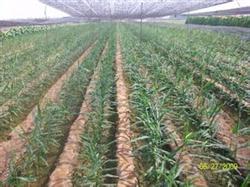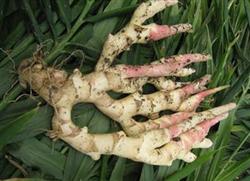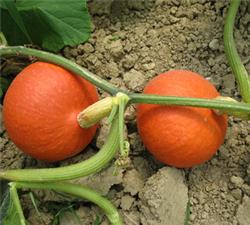High-yield cultivation and Management techniques of Ginger in North China

First, prepare before sowing. 1. Fine soil preparation and application of sufficient base fertilizer. The plots with fertile soil, good irrigation conditions and no ginger blast should be selected to avoid repeated cropping as far as possible. On the basis of winter ploughing, fine soil preparation should be carried out as early as possible in spring, so that the soil can be loosened and fruited without light and dark. Increase the application of organic fertilizer, with the combination of high-quality chicken manure, disease-free residue ring fertilizer, cake fertilizer and plant ash, combined with the application of high-quality rotten chicken manure 4 square or high-quality ring fertilizer 5000ml 10000 kg as base fertilizer. In the high fertilizer and water plot, ditching was prepared according to the row spacing of 60ml / 65cm, and soybean cake 100kg, ternary compound fertilizer 50kg, potassium sulfate 50kg, zinc fertilizer 2kg and boron fertilizer 1kg were applied as seed fertilizer. 2. Select ginger species and cultivate strong buds. About 30 days before sowing, the ginger seeds were taken out from the kiln, the soil on the ginger pieces was removed, and healthy ginger pieces with fat, plump, bright skin, fresh meat, non-drying, non-decay, unfrozen, hard texture and free of diseases and insect pests were selected as seeds. Strictly eliminate ginger seeds that are thin and withered, flesh browning and softening. It is required that the weight of ginger per plant should be up to 50ml 75g, and the general use of ginger per mu is 400ml 500kg. 3. Dry ginger and trap ginger. On a sunny day in early March, at eight or nine o'clock at noon, put the selected ginger seeds on the sunny ground to dry, collect them into the house at night, cover with grass curtains to maintain humidity and darkness, and promote the decomposition of ginger nutrients. Sun-dried ginger for 3 days, trapped seed 8 for 9 days, and kept the temperature at 10 ℃ for 15 min. During this period, nutrients decomposed and promoted bud differentiation. 4. Sprouting. For selected and sun-dried ginger seeds, the seeds were soaked with 200-fold solution of pesticides such as Jiangqisan, Jiangbao and Luba for 10 minutes, which played the role of sterilization, sterilization and budding after drying. Put ginger in baskets and surrounded by wheat straw to keep warm, promote sprouting in the shed or sunny border and other places, keep the air humidity 80% 85%, control the temperature at 22 ℃ 25 mm, and master the high before and low after 20 days, when the ginger bud grows to 0.5 ml 1 cm, sow seeds in batches according to the size of the ginger bud. Second, the main points of management from sowing to seedling stage 1. Sowing and plastic film mulching. According to the local air temperature, ground temperature and the time of late frost, plastic film cultivation can be carried out 20-30 days earlier than conventional sowing. Sowing begins around May 1 in the central part of our province, and sowing in the south of our province can be on April 25-30. Before covering the film, use special herbicide 100m / mu 150g per mu, spray water to avoid weeds under the film. Plastic film can be selected with a thickness of 0.005m2 / 0.006mm and a width of 120mm. 2. Sparse planting properly and enlarge ginger pieces. Properly reduce the planting density, increase the yield per plant, and make the ginger pieces large and neat. The suitable planting density of high-yield plot is about 6500 plants / mu, row spacing is 50-55 cm, plant spacing is 25 cm. The row spacing of the medium fertilizer and water plot is 45cm, the plant spacing is 20cm, the plant spacing is about 8000 plants per mu, and the seed amount is generally about 500kg per mu. 3. Timely shading to promote growth. When the emergence of ginger reaches 50%, the ginger field should be shaded in time to promote the healthy growth of ginger seedlings. The shading net is used for shading, which shades evenly and uniformly, does not destroy the integrity of the plastic film, is convenient for field management, and the ginger seedlings grow vigorously. The specific methods are as follows: the shading net is made into a banner and pulled between the rows of ginger, and the two ends are fixed with bamboo poles with a width of 60rel. 65 cm, the shading rate can be selected as 40% shading net. Try to avoid shading with firewood and grass. Because there are many diseases and insect residues in firewood and grass, especially the overwintering corn borer in corn straw into the ginger field, the base number of ginger field borer is increased, which is not conducive to the control of diseases and insect pests. Third, the main points of management in the middle and later stages of growth: 1. Light application of seedling fertilizer and heavy application of combined branch fertilizer. The supplementary application of autumn fertilizer was combined with watering in the first and middle of June, and 25 kg urea per mu was applied to promote the growth of ginger seedlings. The plastic film was removed in the first and middle of July and 50 kg of ternary compound fertilizer was applied per mu. By August 20, 30 kilograms of potassium sulfate per mu should be added and watered in time after topdressing. In the middle of September, according to the growth of ginger seedlings, appropriate amount of potassium fertilizer or nitrogen fertilizer can be applied, and foliar fertilizer should be applied to the aboveground parts, and potassium dihydrogen phosphate should be sprayed once every 10 days for 4 times in succession, so as to treat diseases and prevent premature senility and prolong the functional period of leaves in the later growth stage. 2. Scientific watering. Because ginger likes wet environment, there must be plenty of water in the field. In order to ensure the smooth emergence of ginger seedlings, on the basis of pouring through the bottom water before sowing, we generally do not water the ginger seedlings before emergence, but wait until 70% of the ginger seedlings are unearthed before watering, which should be flexibly controlled according to the weather, soil texture and soil moisture conditions. If the first water is watered late, the ginger seedlings will suffer from drought and the bud heads will easily dry up. Because the plastic film has a good effect of preserving soil moisture, it is not suitable to water too frequently at the seedling stage, and it is appropriate to pour small water under the plastic film. It is better to water in the morning and evening in summer, not at noon. At the same time, pay attention to timely drainage after rain. Before and after the Beginning of Autumn, the water demand of ginger increased during the vigorous growth period. During this period, water was watered for 5 days to keep the soil moist all the time. In order to ensure less clingy soil and easy storage of ginger after harvest, the last water can be poured 4 days before harvest. After applying branch fertilizer, the soil should be cultivated for 3 times according to the growth of ginger, so as to ensure that the growth does not appear on the soil surface and promote the rapid growth of ginger. Fourth, the prevention and control of main diseases and insect pests. 1. Ginger blast. It is not only a destructive disease, but also a major factor restricting the development of ginger. Comprehensive control measures should be given priority to, crop rotation can be adopted, drainage ditches can be dug and waterlogging prevention can be done, or chemical control can be used to soak the roots with chemical agents such as Fei Su, Zang Jiang Bao, Jiang Fan San, Lvba, etc., and the diseased plants can be pulled out in time. The soil is treated with the above solution and marked with lime, and the soil is buried deeply after the ginger is harvested. 2. Insect pests. During the growth period, the main pests are ginger borer, beet armyworm, ginger thrips and so on. It is necessary to observe the insect situation in time and do a good job of chemical control before major occurrence. Spodoptera litura can be sprayed with insecticides such as Spodoptera litura, Kuaishaling and imidacloprid once every 10 days. 5. Timely harvest when the temperature at the end of autumn is 8 Mel 18 ℃, the autumn is crisp, the light is sufficient, and the temperature difference between day and night is large, which is the key period for the formation of yield. Appropriately extend the growth period and increase the yield. According to the experiment, after Frosts Descent harvested one day every night, he increased an average of 30,000,000 kilograms per mu. In the central part of our province, the best harvest time for ginger harvesting in the field should be about October 20-25, and the southern part of our province can appropriately delay the time of 5 days. At this time, harvesting ginger will not frostbite ginger pieces, and can make full use of the golden period of ginger yield increase in the later stage. Therefore, must grasp the best harvest time, must not harvest prematurely, in order to facilitate storage and nutrient reflux, can leave about 3 cm of stalk. In order to increase the yield, the method of autumn delay can also be used to set up an arch shed in the ginger field before the first frost and delay the protection of agricultural film, so that the ginger growing period can be prolonged by 20-30 days, the yield per mu can be increased by more than 1000 kg, and the yield per mu can reach more than 6000 kg. 6. Ginger is often stored in deep well kiln by digging cellar, which is a method with low investment, easy management and easy operation. 20,000 jin of ginger is stored at a cost of only 200Mel 300 yuan. Generally, the depth is 5 Mel 7 meters, and 3 holes for storing ginger are dug. The temperature in the cellar is maintained at 11 mi 13 ℃, and the relative humidity of the air is kept above 90%. Before entering the cellar, the ginger hole and the bottom of the cellar should be cleaned thoroughly. If it is too dry, properly sprinkle water to keep it moist. When entering the kiln, keep the root of the ginger down. After all, cover the top with a layer of white sand to keep moisture. In order to control ginger maggots and keep the ginger head fresh, the pit holes can be treated with fungicides such as chlorothalonil and carbendazim in advance. After entering the cellar, the ginger kept the hole open and sealed in front of Lesser Snow.
- Prev

Key points of management techniques for high quality and high yield of ginger
First, select the sandy land with deep soil layer, loose and fertile soil and convenient drainage and irrigation, and avoid continuous cropping. 2. Before soil preparation and basic fertilizer sowing, farm manure 1000, 500 kg per mu, calcium magnesium phosphate fertilizer 50 kg, and compound fertilizer 20 kg should be applied as base fertilizer. After application, ploughing and raking should be fully done. Separate borders and open ditches, each 1 wide.
- Next

New varieties of High quality Pumpkin and their cultivation techniques in Spring
Pumpkin is a kind of nutritious and healthy vegetable, while the western pumpkin imported from abroad has less water content, more solids, more non-reducing sugar and starch, more starch / whole sugar ratio, less crude fiber and high crude protein content. therefore, the taste and taste are good, and the quality is much better than that of domestic pumpkins.
Related
- Where is it suitable to grow horseradish in China? it is expected to see the middle altitude horseradish in Alishan.
- How to prevent tomato virus disease reasonably? (Control methods included)
- Many people like to plant towel gourd on the balcony. What are the main points of this method and management?
- What crops can chili peppers be mixed with?
- Fertilization techniques and matters needing attention in Tomato
- What are the grafting techniques for peach seedlings in spring?
- Harm and control methods of root swelling disease of Chinese cabbage
- What are the pests of sweet potatoes? How to prevent and cure it?
- Symptoms, causes and Control methods of navel Rot in Tomato
- The cause of "Cucumber rotten bibcock" in Farmers' planting Cucumber and its Control Plan

